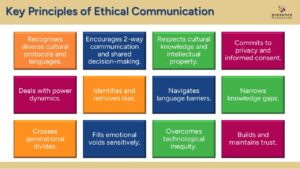How do communication bridges enhance ethical research?
Researchers are well-versed in the ethical principles governing their work, including informed consent, data privacy, and the integrity of scientific inquiry.
The ethical landscape, however, extends beyond the lab or field to encompass how researchers share their findings with the world.
Here are some practical ‘bridges’ for connecting with stakeholders, which reflect the key principles of ethical research communication.
Key principles of ethical communication
But first, what does ethical communication look like?
- Recognises diverse cultural protocols and languages
- Encourages 2-way communication and shared decision-making
- Respects cultural knowledge and intellectual property
- Commits to privacy and informed consent
- Deals with power dynamics
- Identifies and removes bias
- Navigates language barriers
- Narrows knowledge gaps
- Crosses generational divides
- Fills emotional voids sensitively
- Overcomes technological inequity
- Builds and maintains trust
We’ll explore some of these characteristics further on.
Communication bridges
A communication bridge is a deliberate effort to make information flow a two-way process.
Communication bridges shape messages in various formats to overcome barriers to sharing meaning. Like literal bridges, they connect two points that would otherwise be separate.
For research in particular, they serve to translate complex concepts (without condescension) into terms that different types of audiences can grasp.
They help move a conversation from dry facts and figures to a point of understanding and shared purpose.
Communication bridges can connect writers with readers (and presenters with audiences) through:
- Language choices
- Knowledge familiarity
- Cultural considerations
- Generational awareness
- Emotional engagement
- Technology range
Now let’s connect these concepts of communication bridges and ethical research.
Ethical research communication bridges
Here are 9 ways you can use communication bridges to extend the reach, understanding and trust in your research:
1. Preference Plain Language to make the science easier to understand.
2. Use precise language to avoid misleading your readers/audiences.
3. Prioritise the key points so your readers/audiences don’t get lost in the details
4. Respect the humanity of research participants by using “person-first” language, not scientific terms.
5. Acknowledge limitations to protect audiences from making decisions based on incomplete information.
6. Slow the “spin” to manage expectations, discourage sugar-coating, and counter sensationalism.
7. Contextualise findings to show how the research fits in with what is already known and what is still unknown, optimising the force of familiarity.
8. Engage respectfully with diverse perspectives, being open to feedback and constructive dialogue.
9. Vary technology choices, opting for the platforms and channels your readers/audiences prefer.
Addressing power dynamics ethically
Power dynamics affect the trust your readers/audiences have in your communication bridges – how messages are framed, worded, and delivered.
Their perception of your credibility as an expert, especially if they hold scientists in high regard, can influence whether they accept and interpret your messages favourably. It’s a position of power that’s tempting to exploit.
Sometimes your audience has a stronger position of power such as funders and policy designers, which can influence your communication choices.
Conscious communication choices help you manage power dynamics, such as:
- Consulting stakeholders throughout (not just at the start or end) of a project
- Genuinely inviting and considering feedback
- Ensuring research findings are accessible to all stakeholders
- Acknowledging past mistakes or inept methods
- Using inclusive language
- Adapting communication styles
- Striving for equitable representation in research teams and communication materials
Tactics for managing bias risks
As with other communication scenarios, the risk of bias influencing messages and responses can be high.
Universal types of bias that can emerge include:
- Personal
- Similarity
- Curse of knowledge
- False consensus
- Courtesy
- Cultural
- Narrative fallacy
- Language
- Social desirability
- Groupthink/herd mentality
When you are trying to effect significant change through your research (e.g. in policy, behaviour, resource allocation), highlighting bias is a common way for others to suspect or undermine your efforts.
Check your communication before it goes public with these 7 tactics:
1. Use neutral language that doesn’t reinforce outdated stereotypes
2. Seek community input about preferred terminology, technology, location, etc.
3. Compare multiple perspectives as well as data when validating research findings.
4. Corroborate findings with members of the communities that the data represents before you share it widely.
5. Ask colleagues to identify and address potential biases during peer reviews.
6. Include collaborators from different backgrounds to bring more perspective variety to the research process.
7. Clearly state any potential biases or limitations in research reports and communication materials.
Ethical communication is a researcher’s professional responsibility. It ensures their work is presented in ways that reflect the common elements of ethics: respect, honesty and truth, transparency and openness, accuracy, integrity and fairness.
It’s the key to establishing and maintaining trust so that stakeholders can be confident about the value of research outcomes for decision-making and societal benefits.
If you’d like more practical tips on ethical research communication, request a free resource via email to service@presencecommunications.com.au.
And if you’d like to become a more confident communicator, whether or not research is your remit, book a complimentary, unconditional Communication Coaching Clarity Call.
